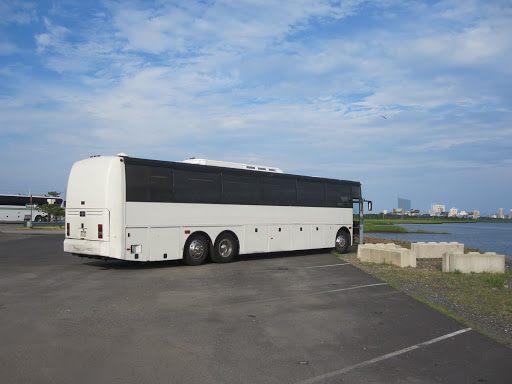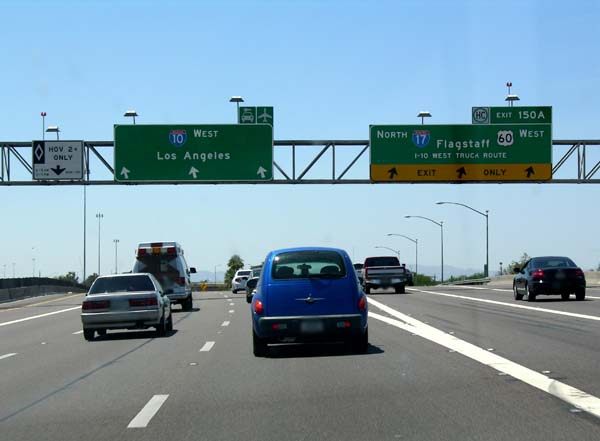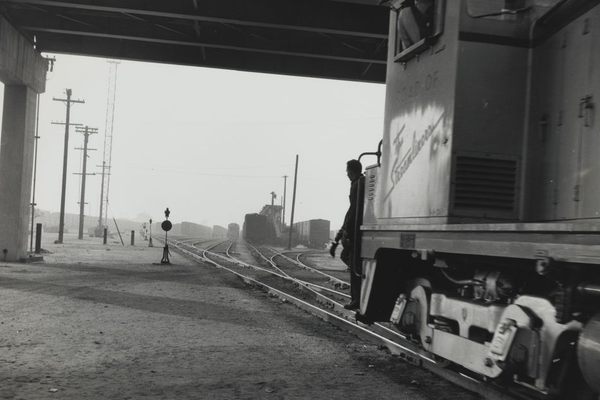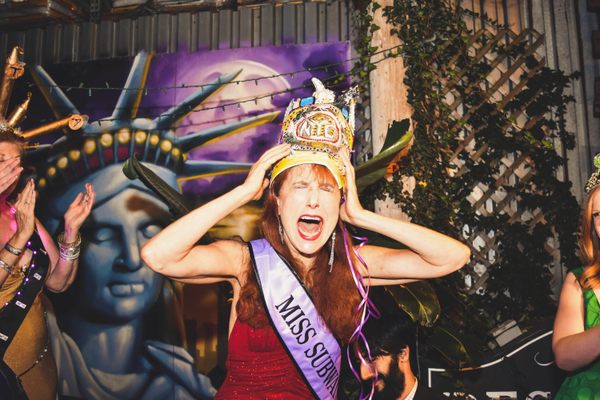The Zombie Bus Scam That Just Won’t Die

A “ghost bus” parked in the Atlantic City Transportation Center. Some reincarnating carriers paint their buses white so that it’s easier to switch them between companies. (Photo: Anonymous/Used with permission)
Let’s say you own a bus company. Specifically, a small bus company–you’re in charge of a few of the thousands of carriers speeding along the highways of the U.S. trying to get students, workers, and other budget-conscious people from point A to point B.
Then, disaster hits (literally): You get into an accident. Passengers are injured, and you’ve been slacking on some safety protocols, so you know it’s your fault. You’re going to get fined at best, or shut down at worst.

What do you do? If you’re a law-abiding type, you take your lumps. But if you’re not, there’s another option. Maybe you’ve secretly registered another bus company, an extra one for situations just like these. Repaint your buses, re-hire your drivers, and you’re back on the road in no time, safety violations be damned. In industry parlance, you’ve reincarnated.
Reincarnation–also called “morphing” or being a “chameleon”–allows bus, trucking, and other transport companies to continue operating after breaking the law. Such companies ”purposely and recklessly endanger every traveler on our highways and roads,” says Duane DeBruyne, spokesman for the Federal Motor Carrier Safety Association (FMCSA), the group tasked with reducing interstate bus and truck crashes. As the busiest travel time of the year approaches, with over 43 million Americans hitting the road to travel to and from Thanksgiving feasts, keeping these dangerous vehicles off the highway is particularly crucial.
A few years ago, reincarnation was ”one of the biggest issues [the bus industry was] dealing with,” says American Bus Association President and CEO Peter Pantuso. Even after vast improvements in detection and enforcement in the decade since the practice was first discovered, it continues to this day–and under trickier and trickier guises. According to safety experts, the difficulties regulators face in this fight shed light on how hard it is to keep a sprawling U.S. transportation industry safe.

Passengers wait to get on a Chinatown bus in Manhattan. (Photo: LuHungnguong/WikiCommons CC BY-SA 3.0)
On March 5th, 2010, drivers on Arizona’s Interstate 10 were pulled into a grisly scene. A bus carrying 20 passengers to Los Angeles from Zacatecas, Mexico rear-ended a pickup truck, skidded across the highway and into the shoulder, tipped over, and kept sliding. By the time it righted itself again, six passengers had died. Investigations soon pinned the tragedy on an uninsured, sleep-deprived driver and defective brakes.
But this accident had a deeper, sneakier root. According to official records, the bus company involved in the crash, Tierra Santa Inc., had only existed for a year. But in reality, it was the latest in a line of bus companies run by the same person. This operator had reincarnated three times in four years, after each of his companies–Tierra Santa Tours, Cayetanos Bus Line Inc., Azteca Bus Line–had racked up enough fines and safety violations to get shuttered. Each successive company used the same buses, drivers, headquarters, and even business cards.
There are a few different ways bus companies can reincarnate, explains Elisa Braver, an epidemiologist who worked in transportation safety for 25 years, and co-author of a 2012 National Transportation Safety Board report on fatal bus crashes. All are possible because it’s relatively easy to start a bus company–all you have to do to get on the road is fill out a form or two and provide proof of insurance, and you’re issued a Department of Transportation (DOT) number. (New interstate bus companies must eventually undergo a safety audit, but that may take a while, as there are only about 1.15 inspectors per 1,000 truck and bus companies, according to a NTSB report.) After that, you’re cruising, unless you get trouble with the FMCSA, who can shut you down if they hear you have violated laws or failed a safety audit.
But if you know how to reincarnate, you can pop right back up again with a new name and DOT number, a clean slate, and all the same buses, drivers, and safety issues. This zombie-like form of reincarnation is the most egregious and illegal, and it’s also the one the FMCSA has been fighting the longest.
Due to their slippery nature, it’s difficult to estimate how many reincarnated carriers are on the road at any given time. But investigations show that the ones that are there pose an outsized danger. Compared to automobile accidents, bus crashes are relatively rare, but when they do occur, they are three times more likely to involve companies with chameleon attributes than above-board companies, according to the 2012 Government Accountability Office (GAO) report. Particularly unsafe companies might go through iteration after iteration until they’re finally stopped by a disaster.

Route 10 in Phoenix, the site of the Tierra Santa, Inc. crash. (Photo: Patriarca12/WikiCommons)
After a 2008 crash of a reincarnated carrier in Houston killed 17 people, the FMCSA began vetting every new bus company for reincarnation by comparing the data they provide on registration forms to existing companies that recently shut down, or are on thin ice. If an address, a phone number, or a driver’s name is the same between companies, that raises suspicion. In their 2012 report, the GAO recommended that the FMCSA further refine its algorithms and registration forms in order to more accurately identify newly registered carriers with chameleon attributes.
In March 2011, just a year after the Tierra Santa crash, the exhausted driver of a World Wide Travel bus packed with 32 revelers returning to New York City’s Chinatown from a Mohegan Sun casino in Connecticut decided, under cover of nightfall, to save time by driving the bus as fast as it could go: 78 miles per hour. As the bus crossed into the Bronx and the sun began to rise, the driver nodded off and sent the bus flying across the shoulder into a guard rail. The bus, full of screaming passengers, flipped onto its side and skidded 500 feet before a highway signpost stopped it, shearing off the top of the bus in the process. Fifteen people died, and the remaining 18 were injured.
An investigation later determined that the driver had been driving the same route with barely any sleep for three straight days and nights, ”only taking short naps inside the bus while passengers were in the casino gambling.” After World Wide Travel got shut down soon after, all but one of its vehicles and most of its employees were quickly transferred to a sister company called Great Escapes, which had been opened by the same owner in 2001.
It took a full year and a number of new violations before Great Escapes was taken off the road in 2012. That’s because that company had used another, trickier form of reincarnation–one that requires more planning ahead, and forces regulators to stay on top of even more information. If a bus company anticipates trouble, they can register multiple DOT numbers from the get-go, as separate entities. Then, ”if one of your companies starts to rack up roadside inspection violations or speeding tickets or crashes, you can transfer your drivers and vehicles to a different company operated by the same management,” says Braver.
Because you’re not registering any new carriers, you’re not going through the chameleon-catching gateway that the FMCSA has implemented. (Registration only has to be updated every two years.) Passengers that choose to take your bus line home for Thanksgiving won’t know you’re essentially the same as the company that got shut down last week.

The World Wide Travel bus crash that killed 15. (Photo: New York State Police/National Travel and Safety Bureau)
Double-dipping is not, in itself, illegal–a carrier “may have legitimate reasons for needing more than one number,” such as actual changes in ownership or a desire to operate in more than one location, says the FMCSA. But it can be, and is, used for shady purposes. Because they were aware of its relation to World Wide Travel, the FMCSA kept a close eye on Great Escapes, and found cause to shut it down in 2012. To enable such oversight, the FMCSA has decided that, starting in September 2016, any company applying for or updating its registration must identify whether it is related to any other existing companies, and which ones.
In general, experts say the FMCSA has made good strides in addressing the problem. In recent years, they have shut down large reincarnation networks focused in Manhattan and California, and their vetting program will soon expand to include all interstate carriers, including trucking companies. “It’s gotten better, certainly, than it was,” says Pantuso. “I’m not sure they’re 100 percent there yet, but they’re certainly moving in the right direction.” A GAO representative confirmed that the FMCSA had implemented two of their four recommendations, and is working on the other two.
But whether reincarnated carriers can ever be wiped out completely is still uncertain. Although Braver says the FMCSA “has been making a very strong effort,” she fears that without the resources to enforce the new rules, simply issuing a different form won’t be enough. Many carriers don’t fill out the ones that are already required. Similarly, she says, the FMCSA’s reliance on data compilation to point out problematic companies is undercut by the fact that they often don’t receive all the right data. Officers who pull over buses for infractions don’t always have the ability to report those infractions in a way that trickles all the way up to the federal level, and states are often lax about sending their crash data to the feds.
Researchers at the University of Michigan Transportation Research Institute found that in 2009, New York reported only 25.3 percent of its bus crashes. In 2008, Florida reported a mere 5.3 percent. Because of this, public safety ratings, reincarnation investigations, and enforcement decisions are all “based on incomplete information,” she says.
Travelers hoping to get some information for themselves can use the FMCSA’s passenger safety website, where is it now possible to check out specific carriers and see if they are flagged for safety violations. Still, says Braver, “if you want to see which company has the best safety records based on violations, inspections, and crashes, that’s much harder.”
“The good news,” says Pantuso, is “there are a lot fewer illegal carriers.” But those who fight them must continue to collect and sort data from multiple sources, keep up with thousands of companies, and pin down shapeshifters who do their best to weave around even the most stringent regulations. The goal, says DeBruyne, is zero reincarnators–to “thwart these rogue and unscrupulous carriers from ever succeeding in returning to our roadways.” But as is true of many bus journeys, how long it will actually take to get there remains to be seen.









Follow us on Twitter to get the latest on the world's hidden wonders.
Like us on Facebook to get the latest on the world's hidden wonders.
Follow us on Twitter Like us on Facebook